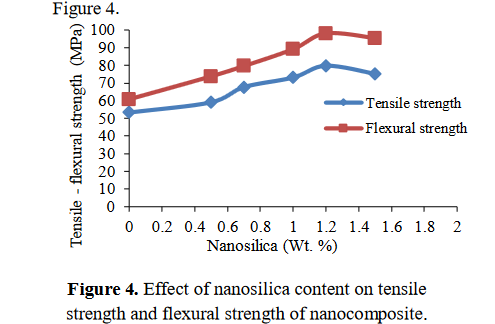Influence of nanosilica on the properties of nanocomposite based on K-153 epoxy resin
Keywords:
Polymer composite, K-153 epoxy resin, nanosilica, nanocomposite, mechanical properties, thermal oxidation resistanceAbstract
This article presents the effects of nanosilica content on some properties of nanocomposite based on K-153 epoxy resin (K-153 epoxy resin was made by modifying ED-20 epoxy resin with thiokol and oligomer acrylate, simultaneously) and polyethylene polyamine (PEPA) (as a hardener). Results show that nanosilica of lower than 1.5 weight percent (wt%) was suitable for K-153 epoxy resin in manufacturing polymer composite. At 80 oC, gelation of K-153 epoxy resin with 1.5 wt% was 79,15 % in comparison to 75,28 % of K-153 neat epoxy. Tensile strength and flexural strength of nanocomposite with 1.2 wt% of nanosilica were 79.81 MPa and 98,14 MPa higher than those of K-153 respectively (53.30 MPa and 60.81 MPa). Besides that, thermal oxidation resistance and remaining ash of nanocomposite also increased in comparison to K-153 epoxy resin.
References
Blackman, B. R. K., Kinloch, A. J., Lee, J. S., Taylor, A. C., Agarwal, R., Schueneman, G., & Sprenger, S. (2007). The fracture and fatigue behaviour of nano-modified epoxy polymers. Journal of Materials Science, 42, 7049-7051. doi:10.1007/s10853-007-1768-6
Ghaemy, M., Bazzar, M., & Mighani, H. (2011). Effect of nanosilica on the kinetics of cure reaction and thermal degradation of epoxy resin. Chinese Journal of Polymer Science, 29(2), 141-148.
doi:10.1007/s10118-010-1003-9
Goodman, S. H. (1998). Handbook of thermoset plastics (2nd ed.). New Jersey: Noyes Publications.
Huang, D., Xu, F., Du, X., Lee, Z., & Wang, X. (2017) . Temperature effects on rigid nano-silica and soft nano-rubber toughening in epoxy under impact loading. Journal of Applied Polymer Science, 134(38), 45319. doi:10.1002/app.45319
Li, S., Liu, X., Fang, C., Liu, N., & Liu, D. (2018). Surface modification and thermal performance of a graphene oxide/novolac epoxy composite. RSC Advances, 8(37), 20505-20516. doi:10.1039/C8RA02847H
Liang, Y. L., & Pearson, R. A. (2009). Toughening mechanisms in epoxy-silica nanocomposites ( ESNs). Polymer, 50 (20), 4895-4905. doi:10.1016/j.polymer.2009.08.014
Manjunatha, C. M., Taylor, A. C., Kinloch, A. J., & Sprenger, S. ( 2009) . The effect of rubber micro-particles and silica nanoparticles on the tensile fatigue behaviour of a glass-fibre epoxy composite. Journal of Materials Science, 44(1), 342-345. doi:10.1007/s10853-008-3092-1
Moore, E. ( 2017) . Fourier transform infrared spectroscopy (FTIR): Methods, analysis, and research insights. New York: Nova Science Publishers.
Morsch, S., Liu, Y., Greensmith, P., Lyon, S. B., & Gibbon, S. R. (2017). Molecularly controlled epoxy network nanostructures. Polymer, 108, 146-153.
Papadopoulos, A., Gkikas, G., Paipetis, A.S., & Barkoula, N.-M. (2016). Effect of CNTs addition on the erosive wear response of epoxy resin and carbon fibre composites. Composites Part A: Applied Science and Manufacturing, 84, 299-307.
Park, J. J., Lee, J. Y., & Lee, H. K. (2017). Surface modification of nanosilica with epoxyterminated silicone and its effect on the electrical breakdown strength in epoxy/nanosilica nanocomposite. Journal of Nanoscience and Nanotechnology, 17(10), 7598-7602.
Potts, J. R., Dreyer, D. R., Bielawski, C. W., & Ruoff, R. S. ( 2011) . Graphene- based polymer nanocomposites. Polymer, 52 (1), 5-25. doi:10.1016/j.polymer.2010.11.042
Radhi, A., Mohamad, D., Abdul Rahman, F. S., Abdullah, A. M., & Hasan, H. (2021). Mechanism and factors influence of graphene-based nanomaterials antimicrobial activities and application in dentistry. Journal of Materials Research and Technology, 11, 1290-1307. doi:10.1016/j.jmrt.2021.01.093
Thanh, N. T. (2019). Effect of technological factors on some properties of composite tube with epoxy resin K-153 matrix. VNU Journal of Science: Natural Sciences and Technology, 35(3), 80-85. doi:10.25073/2588-1140/vnunst.4895
Thanh, N. T. (2020). Effect of drying temperature on some properties of polymer composite with epoxy K-153 matrix. VNU Journal of Science: Natural Sciences and Technology, 36(2), 41-48.
Tsai, J. L., Huang, B. H., & Cheng, Y. L. (2011). Enhancing fracture toughness of glass/epoxy composites for wind blades using silica nanoparticles and rubber particles. Procedia Engineering, 14, 1982-1987. doi:10.1016/j.proeng.2011.07.249













